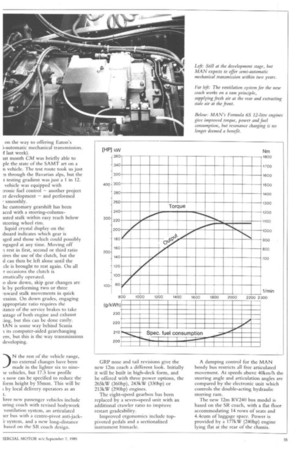MAN NO LONGER GOES IT ALONE
Page 56

Page 57

If you've noticed an error in this article please click here to report it so we can fix it.
As an exponent of resonance charging MAN has for some stood out on its own. Now it appears to have given up that cause. Bill Brock previews the West German manufacturer's latest technical developments which will be unveiled at the Frankfurt motor show next week
MOST commercial vehicle manufacturers seem able to time their development programmes so that the introduction new features coincides with their hoi market shows.
MAN is no exception. Its share of UK market may not be as high as th of most other importers, but in Germany the company holds about 'z third of the market for vehicles over tonnes, and it is listed about eighth i the world ranking.
Next week's International Automc Exhibition at Frankfurt will provide MAN's local venue: before the wrap come off the exhibits, CM offers a preview.
MAN has long been a lone advocz of resonance charging, but has now dispensed with this feature for its tw latest intercooled and turbocharged s cylinder engine. These give power outputs of 213kW (290hp) and 23510 (320hp) — the range currently most popular for maximum-weight trucks Both units follow the pattern set r years ago by the manufacturer's 2651 (360hp) engine, in having been stretc from 11.4 to 12 litres. They share th same bore and stroke, and each has four-hole injector nozzles for better combustion.
As well as delivering power outpu of about 7.5kW (1(1hp) more than th, predecessors, the new 1)2866 LFZ or develop greater torque, especially in medium and lower speed ranges, to improve pulling power and operatim economy from 1,00Orpni upwards tc maximum of 1,200Nni (885 lbft) anc 1,350Nin (996 lb It) respectively.
Noise levels have beer; reduced: M says they more than comply with di' imminent EC81/334 directive. Meast taken include a special coating added the engine sump, modifications to Ix air intake and exhaust systems, and t fitting of more compact insulation o, the cab floor.
MAN has already moved toward reducing the driver's tasks by introducing Eaton's twin-splitter transmission and the company is no on the way to offering Eaton's i-automatic mechanical transmission. / last week).
ist month CM was briefly able to pie the state of the SAMT art on a n vehicle. The test route took us just la through the Bavarian alps, but the t testing gradient was just a 1 in 12. vehicle was equipped with cronic fuel control — another project er development — and performed smoothly.
he customary gearshift has been aced with a steering-column toted stalk within easy reach below steering wheel rim.
liquid crystal display on the iboard indicates which gear is tged and those which could possibly ngaged at any time. Moving off -1 rest in first, second or third ratio iires the use of the clutch, but the 11 can then be left alone until the de is brought to rest again. On all r occasions the clutch is imatically operated.
o slow down, skip gear changes are le by performing two or three ,nward stalk movements in quick rssion. On down grades, engaging appropriate ratio requires the ;tance of the service brakes to take image of both engine and exhaust :ing, but this can be done easily. IAN is some way behind Scania its computer-aided gearchanging ern, but this is the way transmissions developing.
)N the rest of the vehicle range, no external changes have been made in the lighter six to ninele vehicles, but 17.5 low profile
s now can be specified to reduce the form height by 55mm. This will be i by local delivery operators as an t.
hree new passenger vehicles include U ring coach with revised bodywork ventilation system, an articulated ier bus with a centre-pivot anti-jack'e system, and a new long-distance based on the SR coach design. GRP nose and tail revisions give the new 12m coach a different look. Initially it will be built in high-deck form, and be offered with three power options, the 265kW (360hp), 243kW (330hp) or 213kW (290hp) engines.
The eight-speed gearbox has been replaced by a seven-speed unit with an additional crawler ratio to improve restart gradeability.
Improved ergonomics include toppivoted pedals and a sectionalised instrument binnacle. A damping control for the MAN bendy bus restricts all free articulated movement. At speeds above 40ktn/h the steering angle and articulation angles are compared by the electronic unit which controls the double-acting hydraulic steering ram.
The new 12m RV240 bus model is based on the SR coach, with a flat floor accommodating 14 rows of seats and 4.4cum of luggage space. Power is provided by a 177kW (240hp) engine lying flat at the rear of the chassis.




































































































